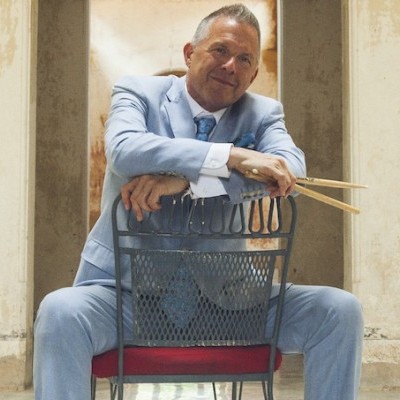Oct 28, 2025 10:47 AM
In Memoriam: Jack DeJohnette, 1942–2025
Jack DeJohnette, a bold and resourceful drummer and NEA Jazz Master who forged a unique vocabulary on the kit over his…
Ethan Iverson is almost as good at Twitter as he is at piano.
Whether folks have come to his music through recent leader dates, his previous work with The Bad Plus or his writing on the Do The Math blog or in The New Yorker, Iverson recently started posting quick-hit interpretations of TV themes to the social media platform.
Since April 18, he’s shared short videos of themes from The Pink Panther, Newhart and Sanford and Son, among others, the material functioning as an inexhaustible well to draw from amid the pandemic. Iverson said he’s aiming to hit 30 in total.
“I don’t do anything that I don’t like. And I’ve always had an interest in TV themes when they resonated with me,” the pianist said from his home in New York. “I’ve also always enjoyed watching TV. I’m old enough that the theme from The A-Team, it’s sort of inside me as genuine generative material, I would say. I really got into Twin Peaks, and the music really meant something.”
TV theme no. 14) MURDER, SHE WROTE by John Addison pic.twitter.com/raqsIWtmwJ— Ethan Iverson (@ethan_iverson) April 26, 2020
There’s a potential for TV themes like these to be dismissed. But music associated with The Simpsons or Seinfeld also can immediately summon a mood and characterize a moment in time. Of course, TV is different now than in the past; Netflix almost encourages you to skip over the opening credits. But Iverson sees something much deeper in these short compositions.
“With all of them, I think they have compositional lessons to teach, absolutely,” he began. “If you think it’s easy to write a TV theme, you do it [laughs]. These iconic TV themes, they have little moments of true brilliance, in terms of composition. Writing a hook. Writing a little section. Even Peter Gunn—[it’s] objectively corny. But there are harmonic details about Henry Mancini there that are quite idiosyncratic and complicated.”
Premising playful content on music that’s familiar to a huge portion of the public, though, is similar to how the pianist first rose to prominence. At least some of The Bad Plus’ renown initially sprang from deft interpretations of songs like Nirvana’s “Smells Like Teen Spirit” or Abba’s “Knowing Me Knowing You.”
The objective of those early albums might not have been to create an open space for the uninitiated, but it certainly functioned that way for some developing young jazz fans. But for this current project, Iverson—who said an album-length exploration of TV material wasn’t out of the question—seems to be angling for a palliative aspect in his work.
“No one needs me to tell them that it’s rough out there,” he said about people who have engaged with his Twitter posts. “So, whatever I’m doing, I’m trying to keep it light.” DB
If Iverson is able to draw on an interest in TV themes, there’s potentially a way for anyone stuck at home to access new creative flights. Read thoughts—lightly edited—on the subject from a range of notable jazz players, all working toward self-care and bettering their own practices.

Jack DeJohnette boasted a musical resume that was as long as it was fearsome.
Oct 28, 2025 10:47 AM
Jack DeJohnette, a bold and resourceful drummer and NEA Jazz Master who forged a unique vocabulary on the kit over his…

Always a sharp dresser, Farnsworth wears a pocket square given to him by trumpeter Art Farmer. “You need to look good if you want to hang around me,” Farmer told him.
Sep 23, 2025 11:12 AM
When he was 12 years old, the hard-swinging veteran drummer Joe Farnsworth had a fateful encounter with his idol Max…

D’Angelo achieved commercial and critical success experimenting with a fusion of jazz, funk, soul, R&B and hip-hop.
Oct 14, 2025 1:47 PM
D’Angelo, a Grammy-winning R&B and neo-soul singer, guitarist and pianist who exerted a profound influence on 21st…

Kandace Springs channeled Shirley Horn’s deliberate phrasing and sublime self-accompaniment during her set at this year’s Pittsburgh International Jazz Festival.
Sep 30, 2025 12:28 PM
Janis Burley, the Pittsburgh International Jazz Festival’s founder and artistic director, did not, as might be…

Jim McNeely’s singular body of work had a profound and lasting influence on many of today’s top jazz composers in the U.S. and in Europe.
Oct 7, 2025 3:40 PM
Pianist Jim McNeely, one of the most distinguished large ensemble jazz composers of his generation, died Sept. 26 at…